There’s a famous Japanese saying that goes “Never say kekko until you’ve seen Nikko.”
The term “kekko” means magnificent, splendid, or wonderful, and it truly encapsulates the essence of Nikko.
In Nikko, you can explore UNESCO World Heritage sites, admire intricate temple architecture, wander through serene gardens, and experience some of Japan’s most famous waterfalls.
I visited Nikko for 5 days in 2024 and found that there is no shortage of things to do in Nikko – and even a 2-day trip barely scratches the surface of what this mountain town has to offer!
In this 2 Day Nikko itinerary, I’ll share exactly how I would spend 2 days in Nikko on my first visit. I’ll go over where to stay, how to get around, and exactly what to do each day!
If you only have 2 days in Nikko, this itinerary hits all of the highlights of Nikko to ensure you have an unforgettable adventure in this beautiful region of Japan!
If you are based in Tokyo you can check out the top-rated Nikko One Day Tour from Tokyo, which includes transportation and a guide to this Japanese mountain town.

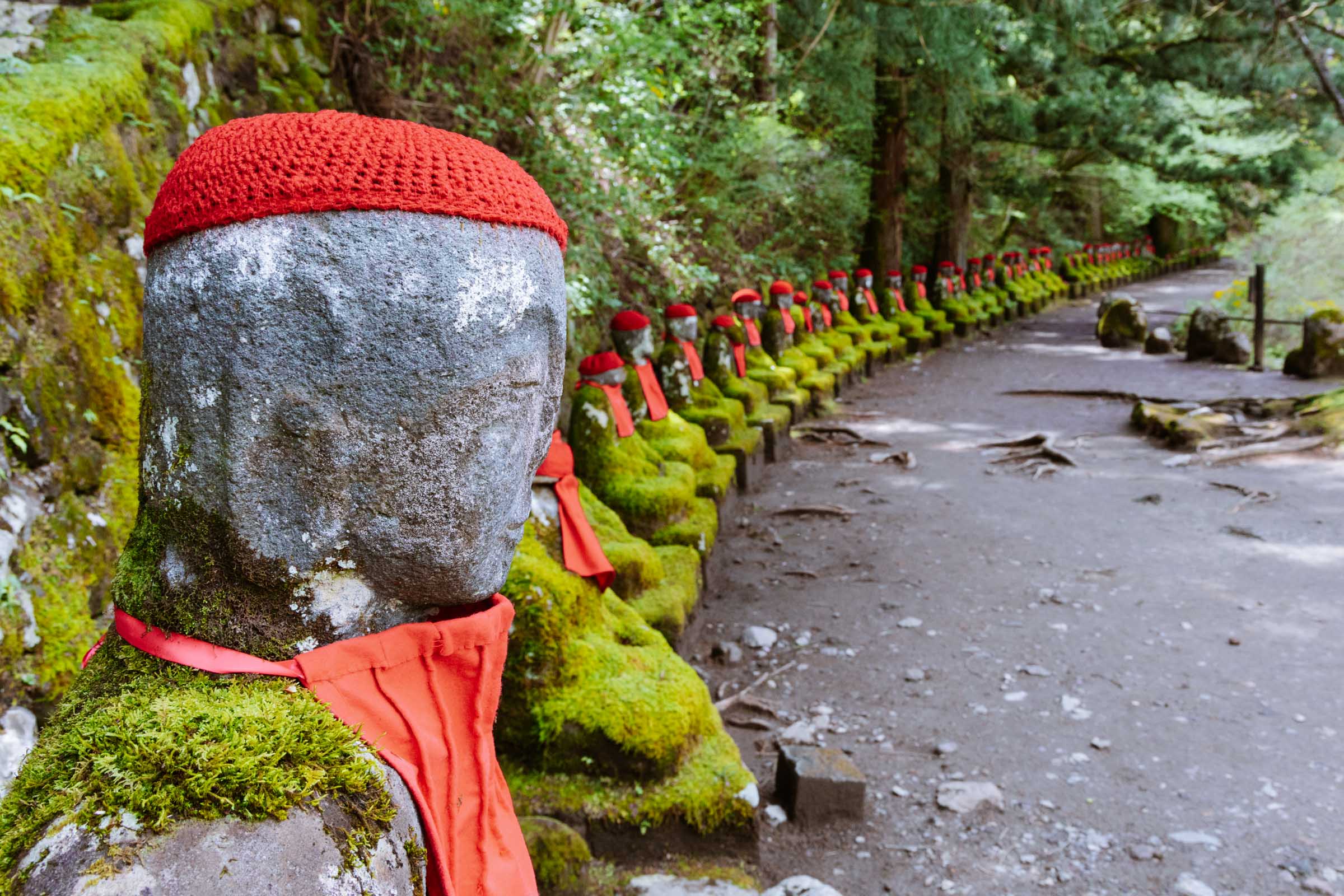
How to Spend 2 Incredible Days in Nikko: A First-Timers Guide and Itinerary
Where to Stay in Nikko
If this is your first trip to Nikko, you are probably wondering where to stay!
There are four main areas to consider, but for first-time visitors, Central Nikko and the Okunikko (Lake Chuzenji) area are the best choices.
These locations provide easy access to most activities and attractions, making your visit a lot more convenient.
Central Nikko
If you want to make the most of your time in Nikko, staying in Central Nikko near the world heritage shrines and temples is the most convenient option.
Central Nikko gives you easy access to the main sightseeing spots, bus routes, and plenty of dining options. This makes planning your daily adventures more straightforward.
However, keep in mind that most accommodations in Central Nikko lean towards the luxury side, so budget-friendly options are limited.
Okunikko and Lake Chuzenji
If you’re a nature lover, the Lake Chuzenji and Okunikko area is your perfect base.
Lake Chuzenji is surrounded by hiking trails, waterfalls, and scenic viewpoints. You could easily spend a couple of days here just exploring the outdoors!
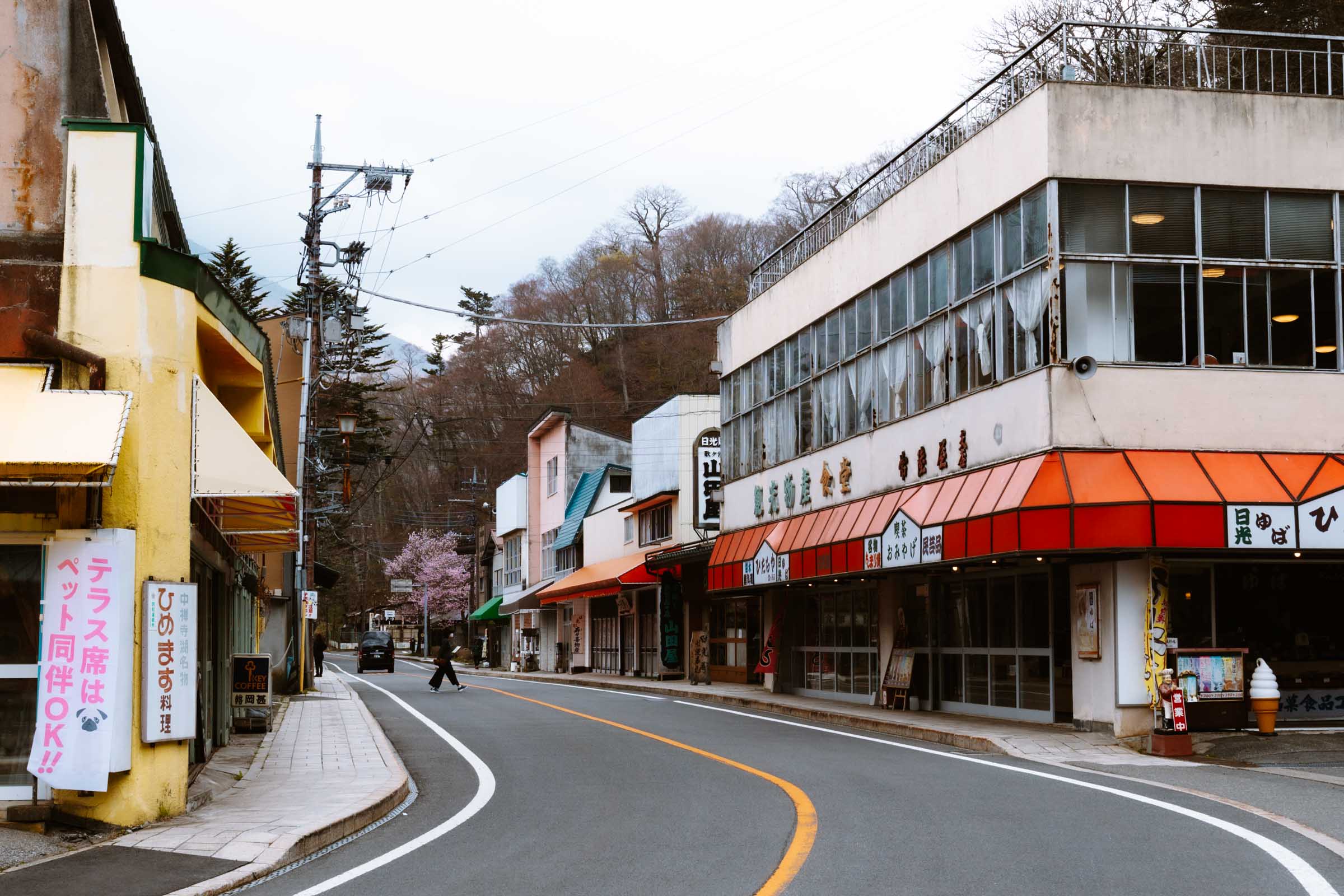
How to Get Around Nikko
Nikko’s bus system is quite convenient, running as frequently as every 15 minutes to major sightseeing areas. For trips further out, expect less frequent service, but it’s still manageable.
In the past, navigating Nikko’s bus system meant relying on route timetables. I’m happy to tell you that’s no longer the case!
Nikko’s buses are now integrated with Google Maps, allowing you to easily enter your destination, select transit options, and receive real-time information on which bus to take and where to get on and off. This makes getting around Nikko much more straightforward.
In my itinerary below, I’ll outline how to explore Nikko without a car. Most attractions are easily accessible by walking or public transport.
For the greatest flexibility, driving is the best option in Nikko. Many attractions are spread out, and you’ll find plenty of parking at most destinations. A car allows you to explore at your own pace and see everything that Nikko has to offer.
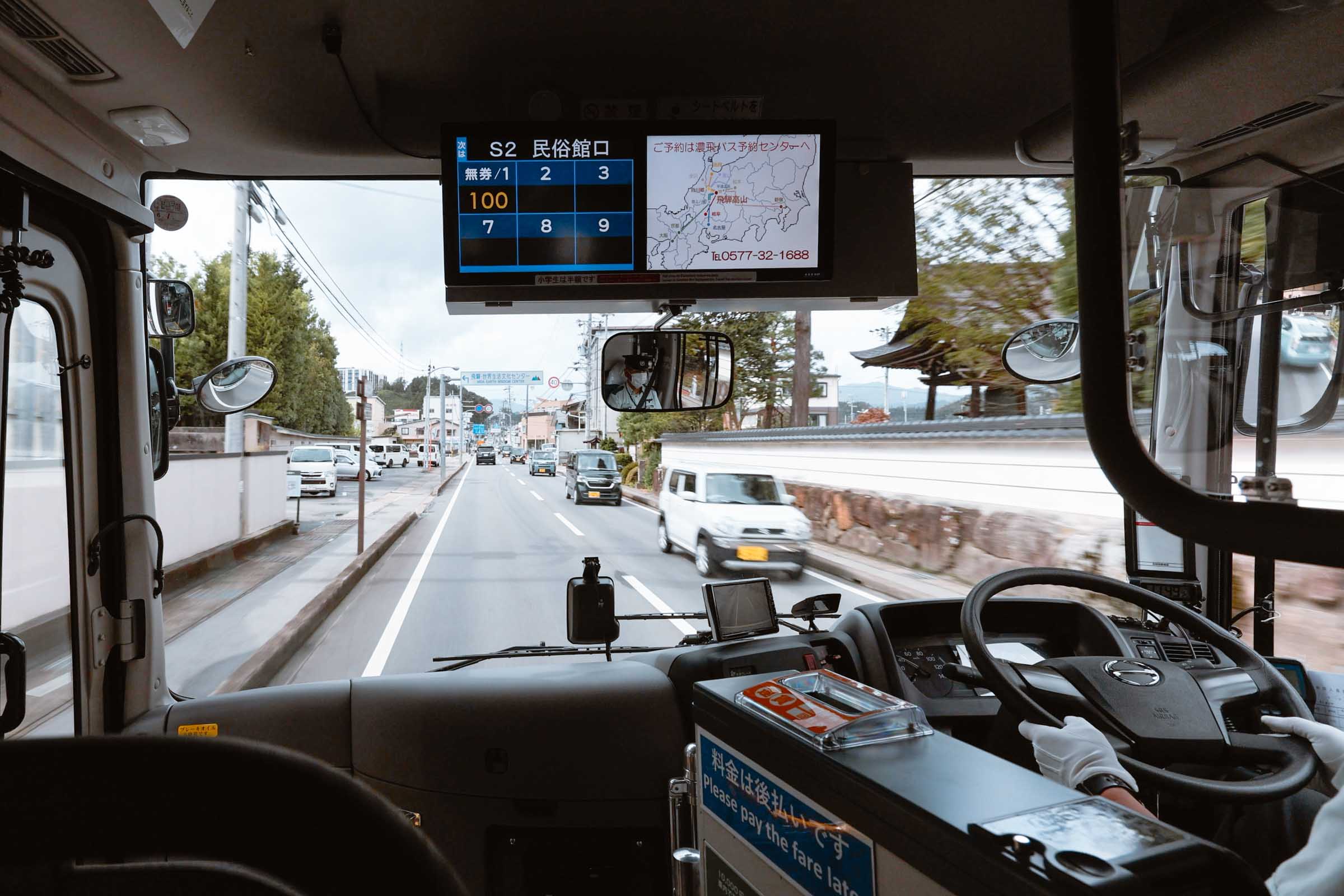
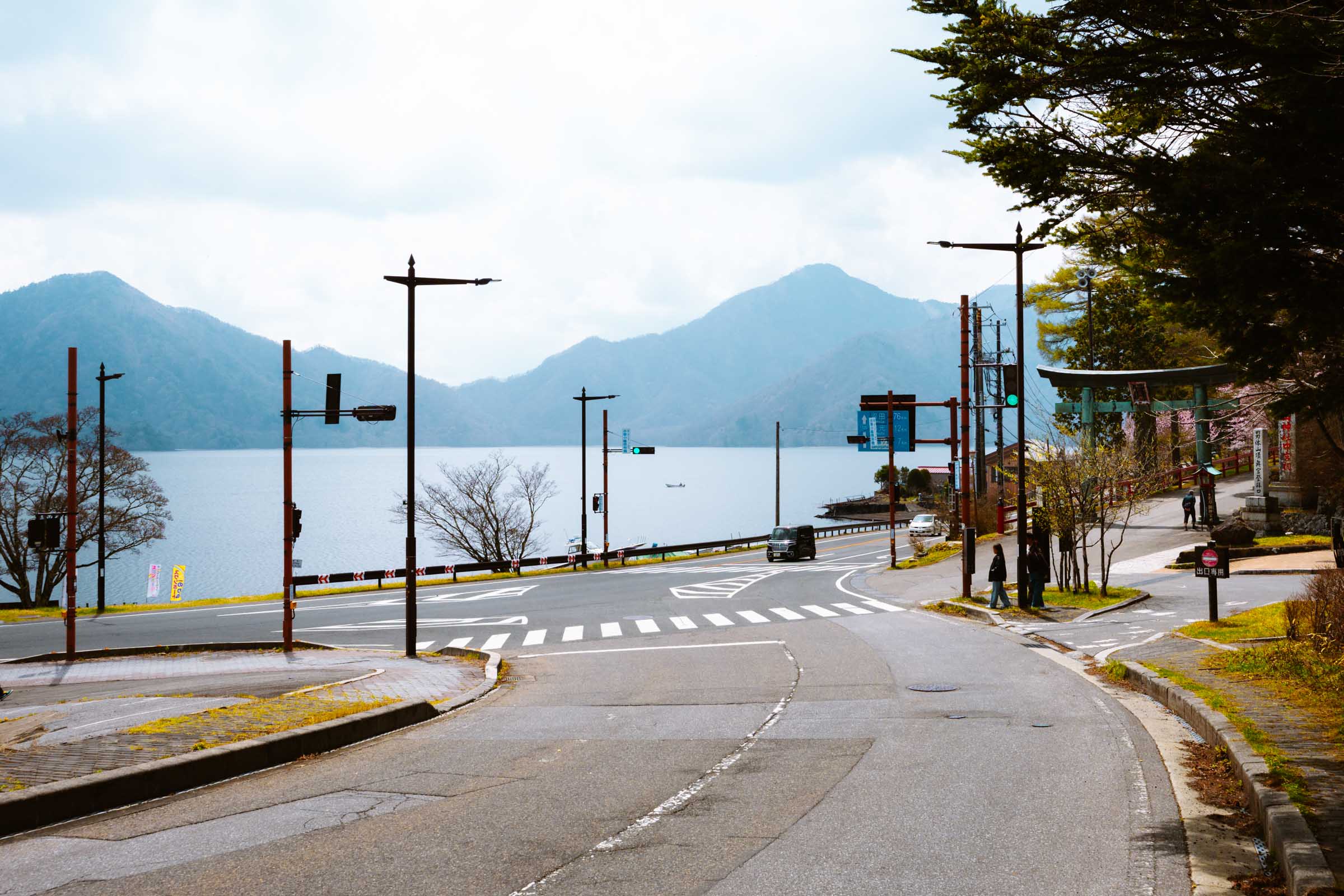
Nikko Day 1: Temples, History, and Scenic Beauty
It’s the first day of your 2-day adventure in Nikko – welcome!
Today, you’ll explore the renowned sights around central Nikko. Begin your journey at the World Heritage Shrines and Temples, then take a stroll through the town to discover some of its quieter corners. Let’s get started!
World Heritage Shrines and Temples
Our first stop is the UNESCO World Heritage Shrines and Temples of Nikko. As the top attraction in the area, it’s fitting to begin here!
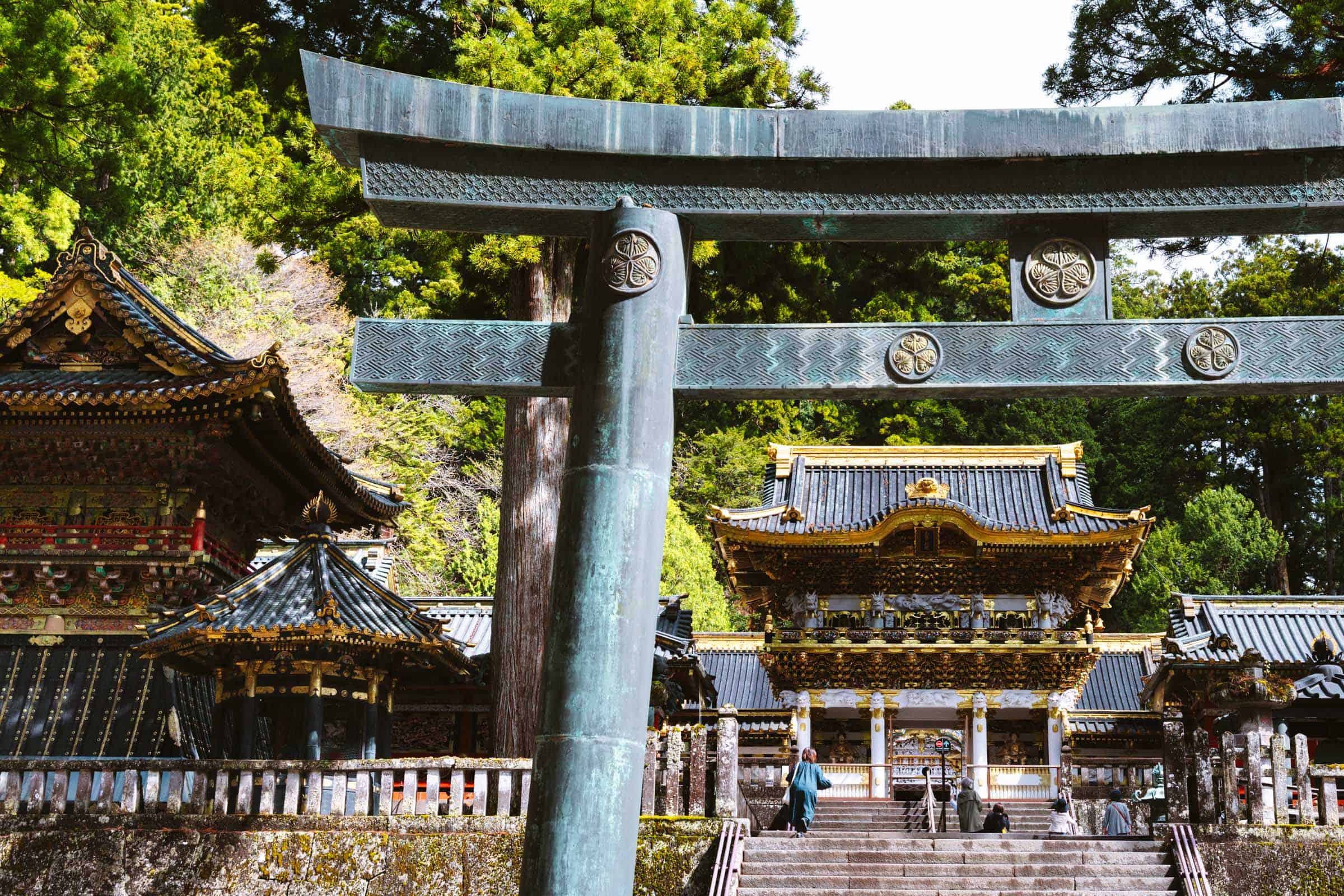
As you explore these UNESCO-designated sites, you’ll be surrounded by stunning architecture and intricate carvings, all infused with Buddhist and Shinto spirituality.
Below, I’ll provide an overview of what to expect at the main areas of the Shrines and Temples in Nikko.
Shinkyo Bridge
At the entrance to the Shrines and Temples of Nikko, the Shinkyo Bridge serves as the symbolic gateway to the UNESCO World Heritage area. The red bridge contrasts beautifully against the lush, forested mountains that shift in color throughout the seasons.
Historically, this sacred bridge was reserved only for the elite and was off-limits to the public. But today, you can actually cross it yourself (for a small fee, of course).
However, most people prefer to admire the bridge from a distance. Standing on the sidewalk of the adjacent bridge provides a great vantage point to capture a photo of the iconic red Shinkyo Bridge spanning the Daiya River with the mountains as a backdrop.
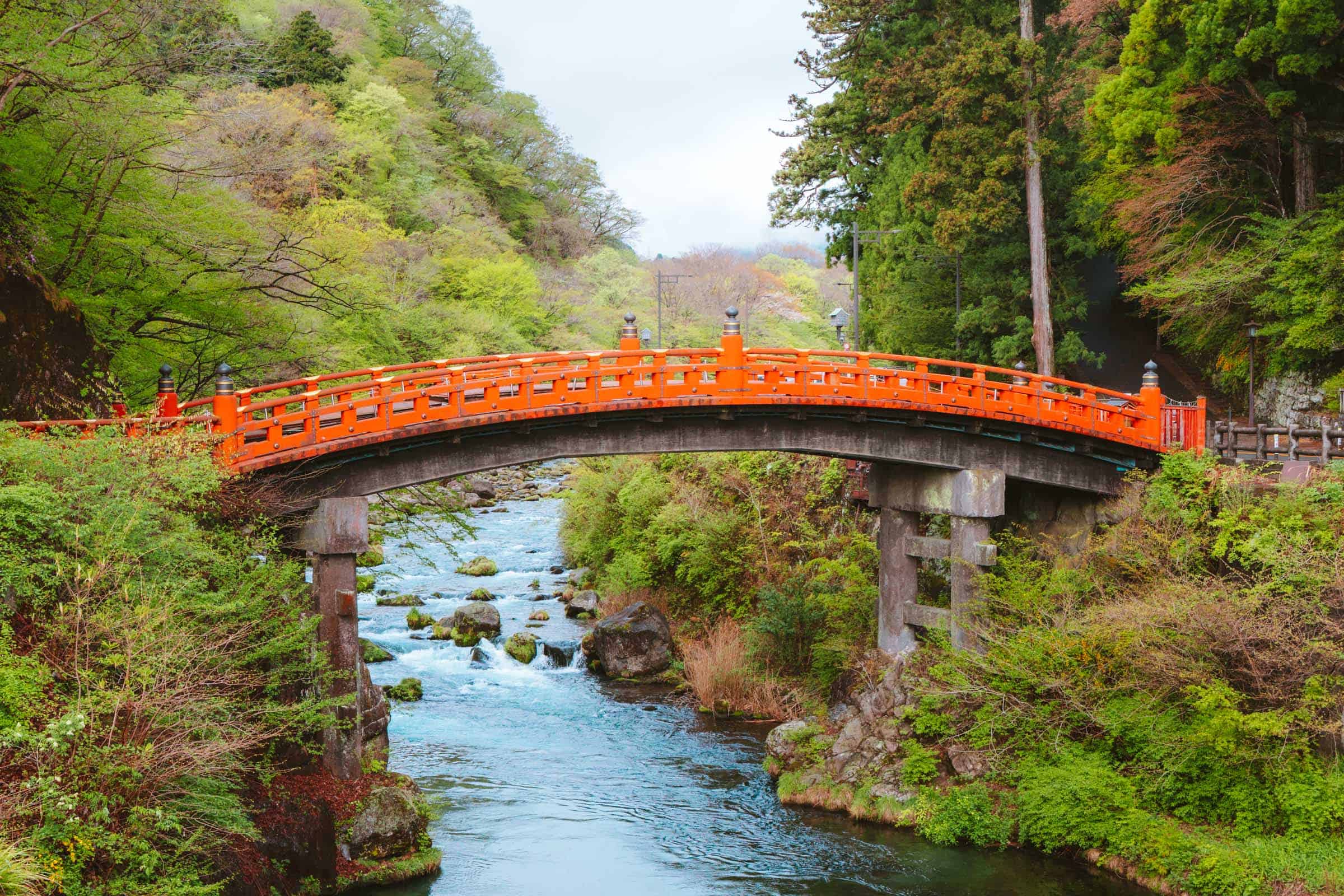
Rinnoji Temple
Rinnoji Temple is the most significant Buddhist temple in Nikko. Its main hall, Sanbutsudo, houses three massive gold statues of Nikko’s Buddhist deities. Each of these statues stands 8 meters tall and represents aspects of the area’s Shinto gods. I’m surprised at how they even got into the building!
Next to Rinnoji Temple is Shoyoen, a small Japanese-style garden that is popular for viewing autumn colors, with its maple trees beautifully framing its central pond.
Unfortunately, you aren’t allowed to take any photos inside of Rinnoji temple, so you’ll just have to go see it for yourself!

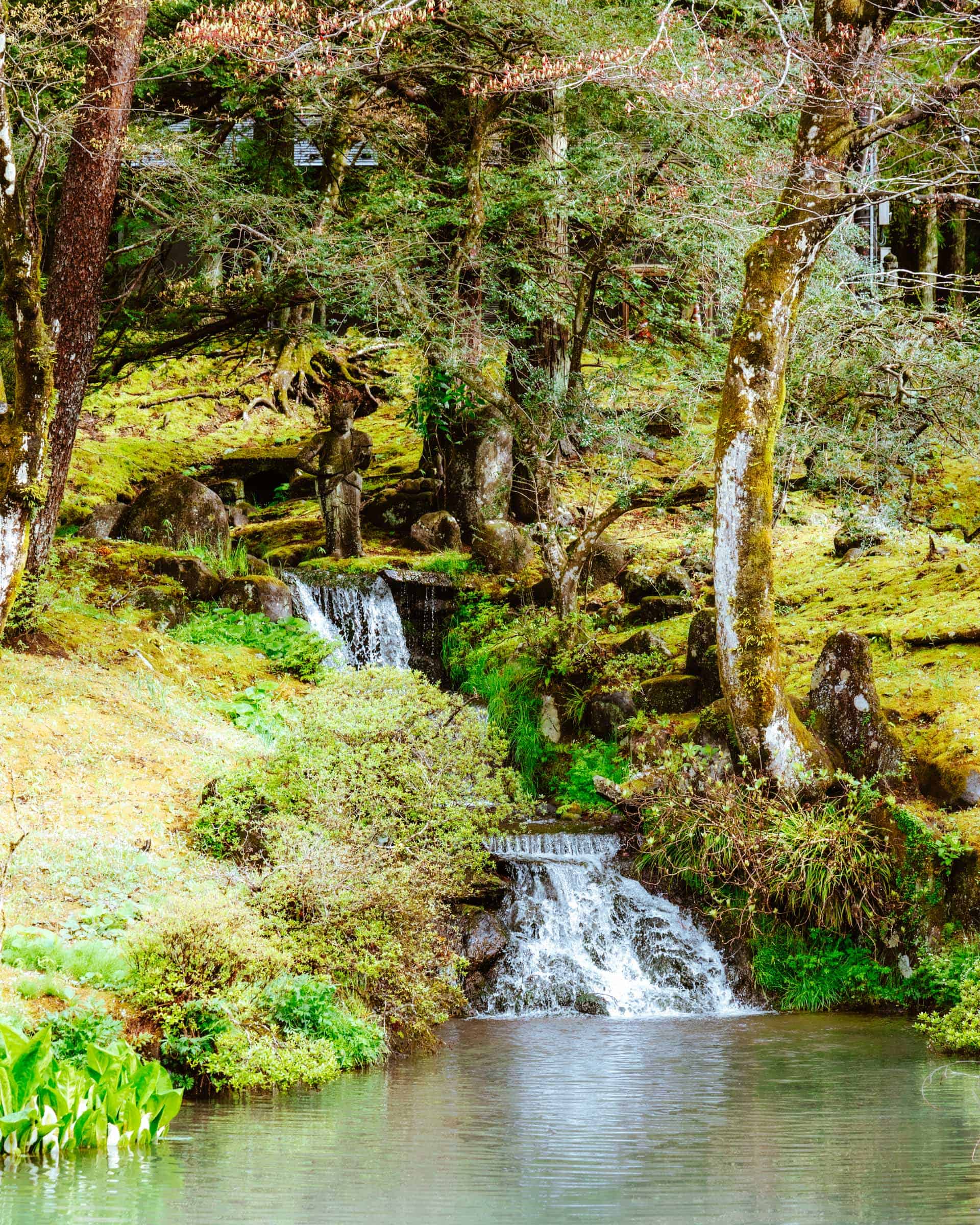

Toshogu Shrine
Next stop, the Toshogu Shrine! This isn’t your typical Shinto shrine. It honors Tokugawa Ieyasu, the unifier of Japan, whose final resting place is here.
Before you enter the shrine, take a moment to appreciate the Gojū-no-tō, the five-storied pagoda located just outside the gate. The five tiers of the pagoda represent the five elements of Buddhist cosmology, and the pagoda is painted red to ward off evil spirits.
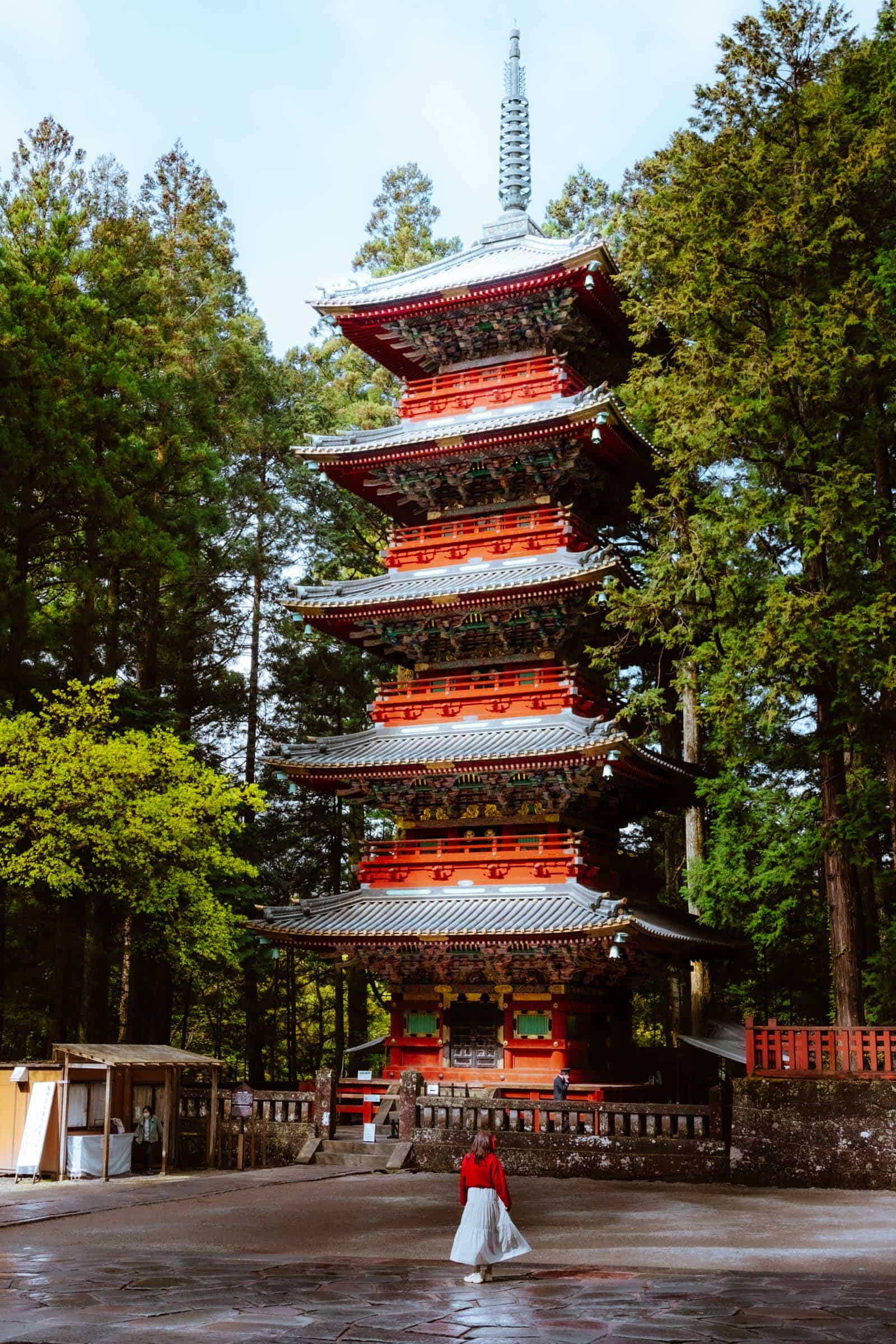
Once inside the shrine complex, you’ll find no shortage of intricate details, especially at the Yomeimon Gate, known as the “Sunset Gate.” The gate is covered with complex wood carvings, bright paintings, and gold leaf. It’s truly a remarkable sight!

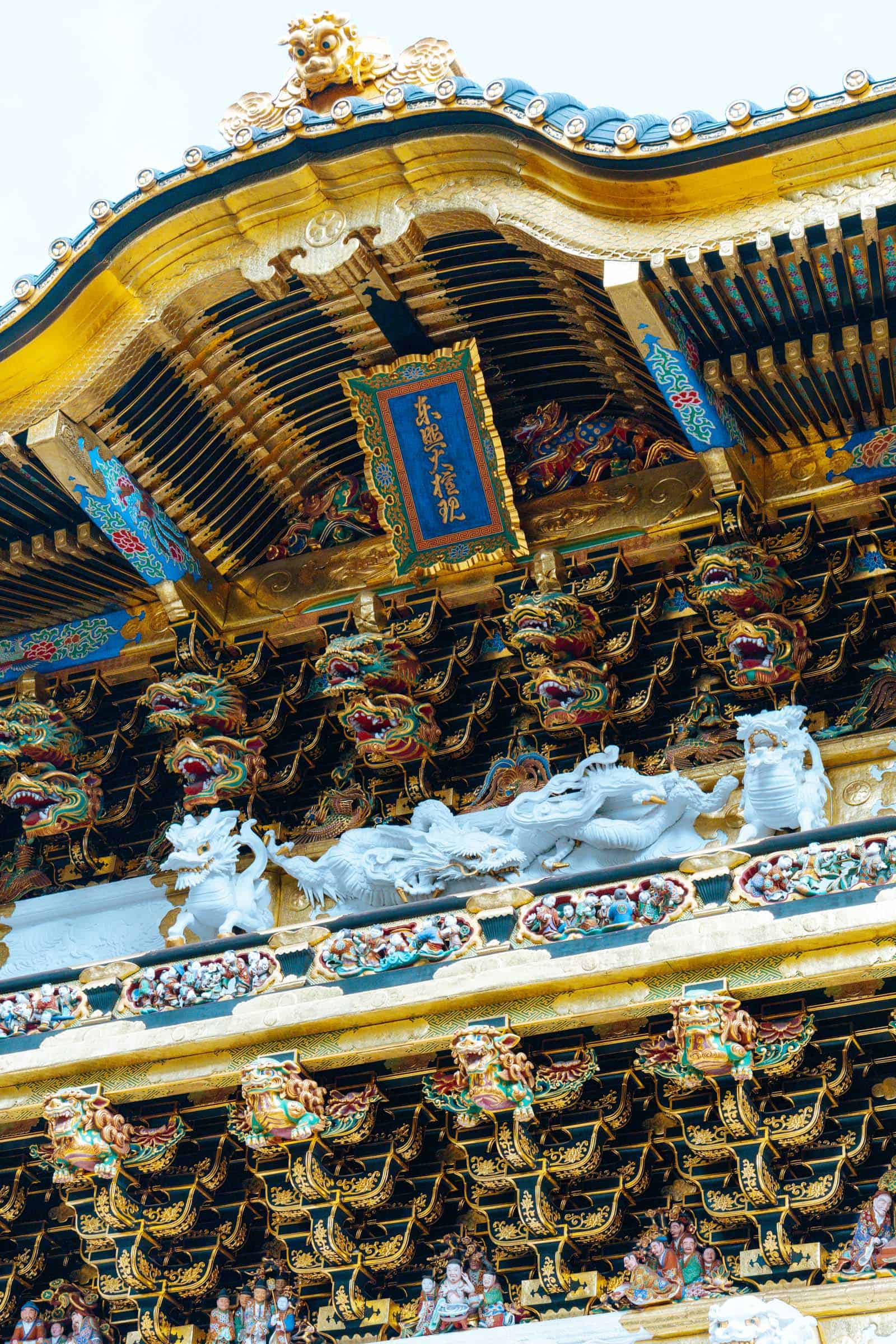
While you explore Toshogu Shrine, be sure to look for the famous carving of The Three Monkeys, representing “See No Evil, Speak No Evil, Hear No Evil.”
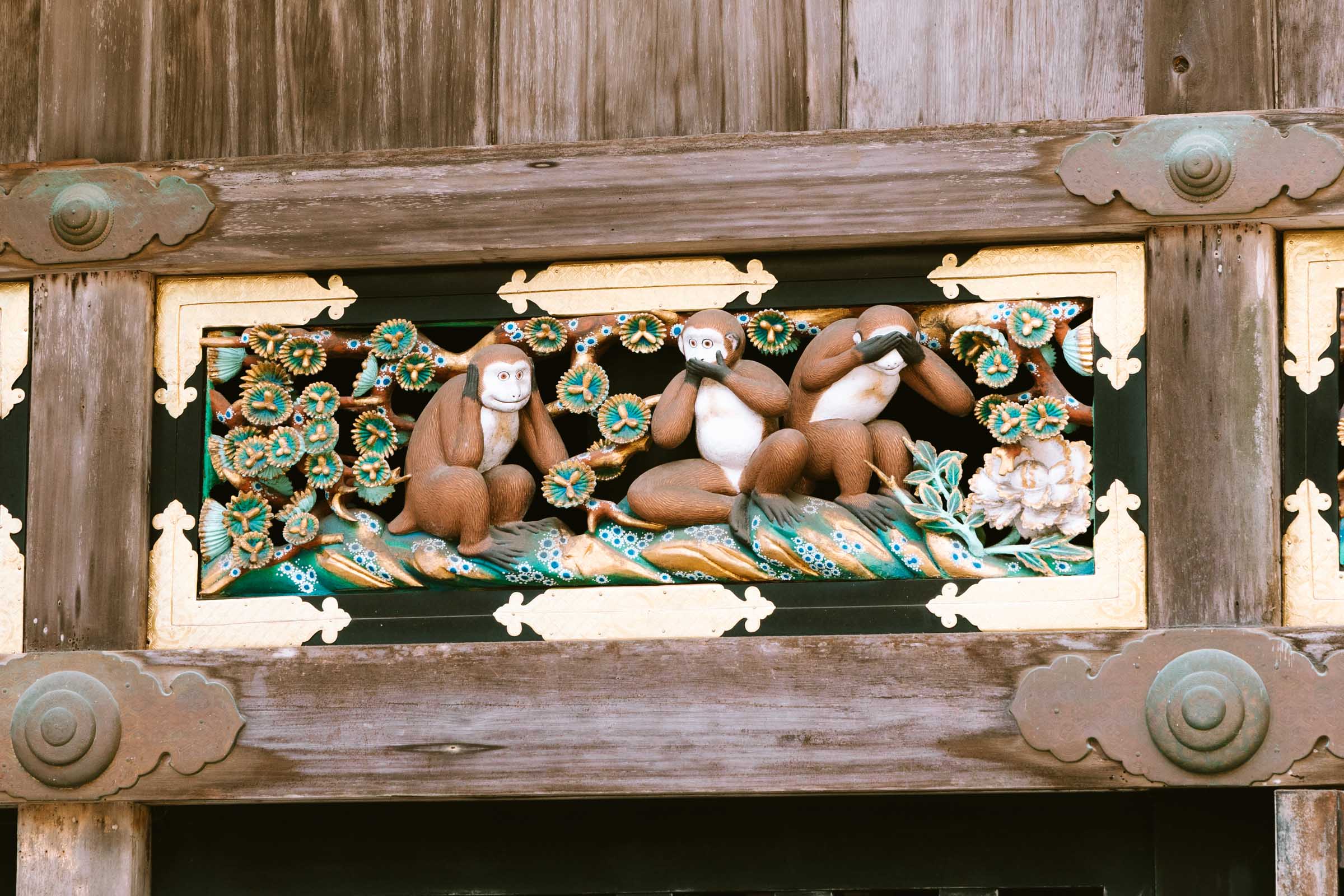
Tokugawa Ieyasu’s resting place is a little tricky to find. After passing through the Yomeimon Gate, turn right and pass through the gate with the Nemuri-neko (Sleeping cat carving). Follow the stone pathway and climb the stairs to Tokugawa’s final resting place.

Futarasan Shrine
Next, stroll over to the Futarasan Shrine. It’s surrounded by the sacred mountains of Nikko and is tucked away in the forest.
This shrine is dedicated to the deities of Nikko’s three most revered mountains: Mount Nantai, Mount Nyoho, and Mount Taro. These mountains have been worshipped as gods, making the shrine an important site for spirituality.
Today, the shrine attracts visitors seeking prayers for good luck, fertility, and happiness in marriage. Its setting enhances the experience, inviting quiet reflection and connection with nature.
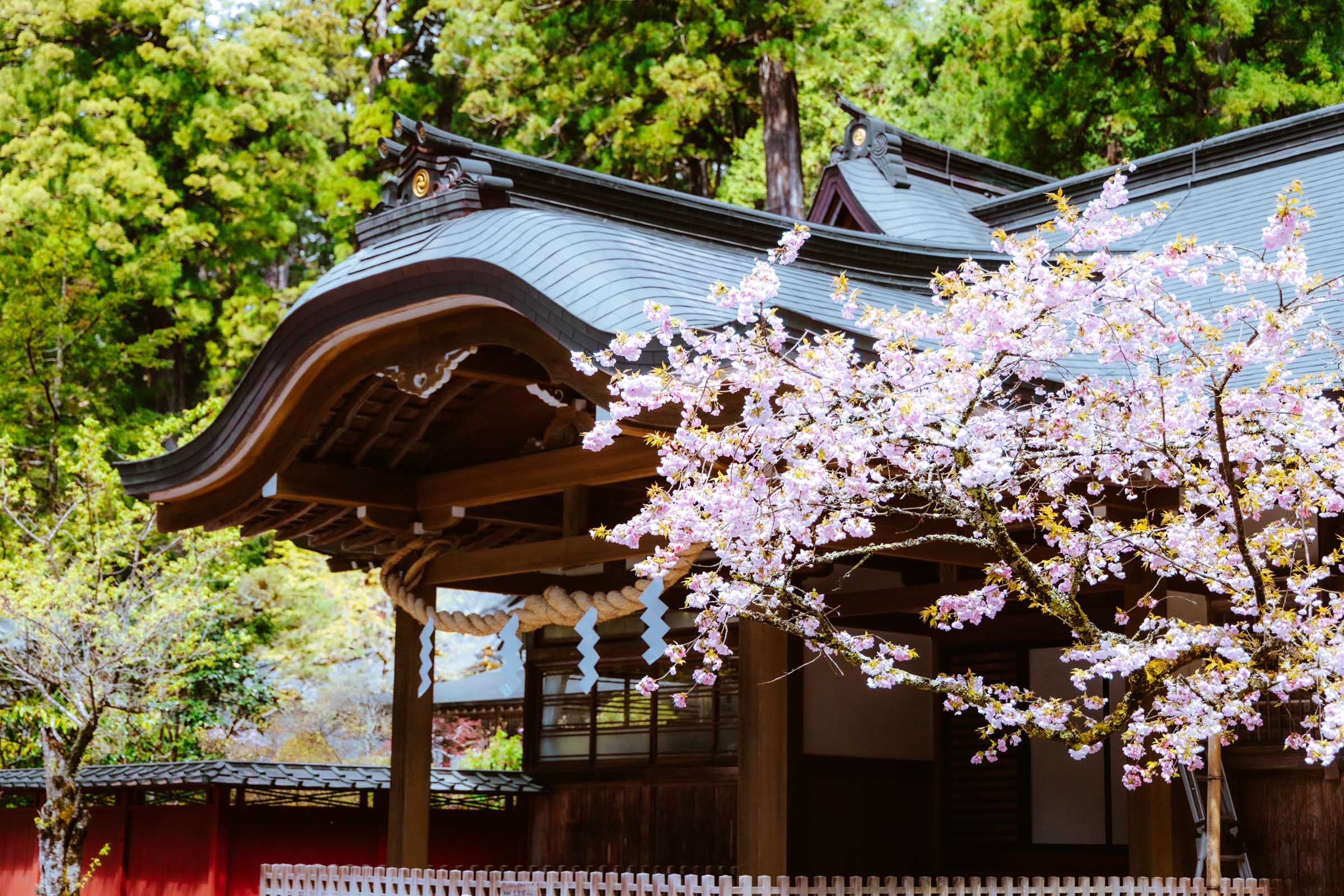

Kanmangafuchi Abyss
After enjoying your time at the World Heritage Shrines and Temples, make your way to Kanmangafuchi Abyss, a truly unique and serene spot. It’s about a 20-minute walk from the world heritage shrines and temples.
This volcanic gorge has a river flowing through it. But what truly sets it apart are its charming stone Buddha statues, each adorned with little handmade hats and bibs!
It’s such a cute sight, and seriously so Japan! It certainly makes you wonder who took the time to create these little red outfits for the Buddhas.
To reach Kanmangafuchi Abyss, start at Kanman Park and follow the path along the river. You’ll soon notice a bright red hat peeking through the greenery, marking the way.
The beginning of the path is narrow with just a handful of statues, but as you continue, it opens up to reveal a long stretch of these stone red-clothed figures.

In fact, it’s rumored that no one can truly count them all, as their number seems to change every time! I counted 70 statues, while Trey counted 71!
Who knows? Maybe a Buddha has wandered off somewhere! You’ll have to see this place and try counting them for yourself—perhaps you’ll have better luck figuring it out!
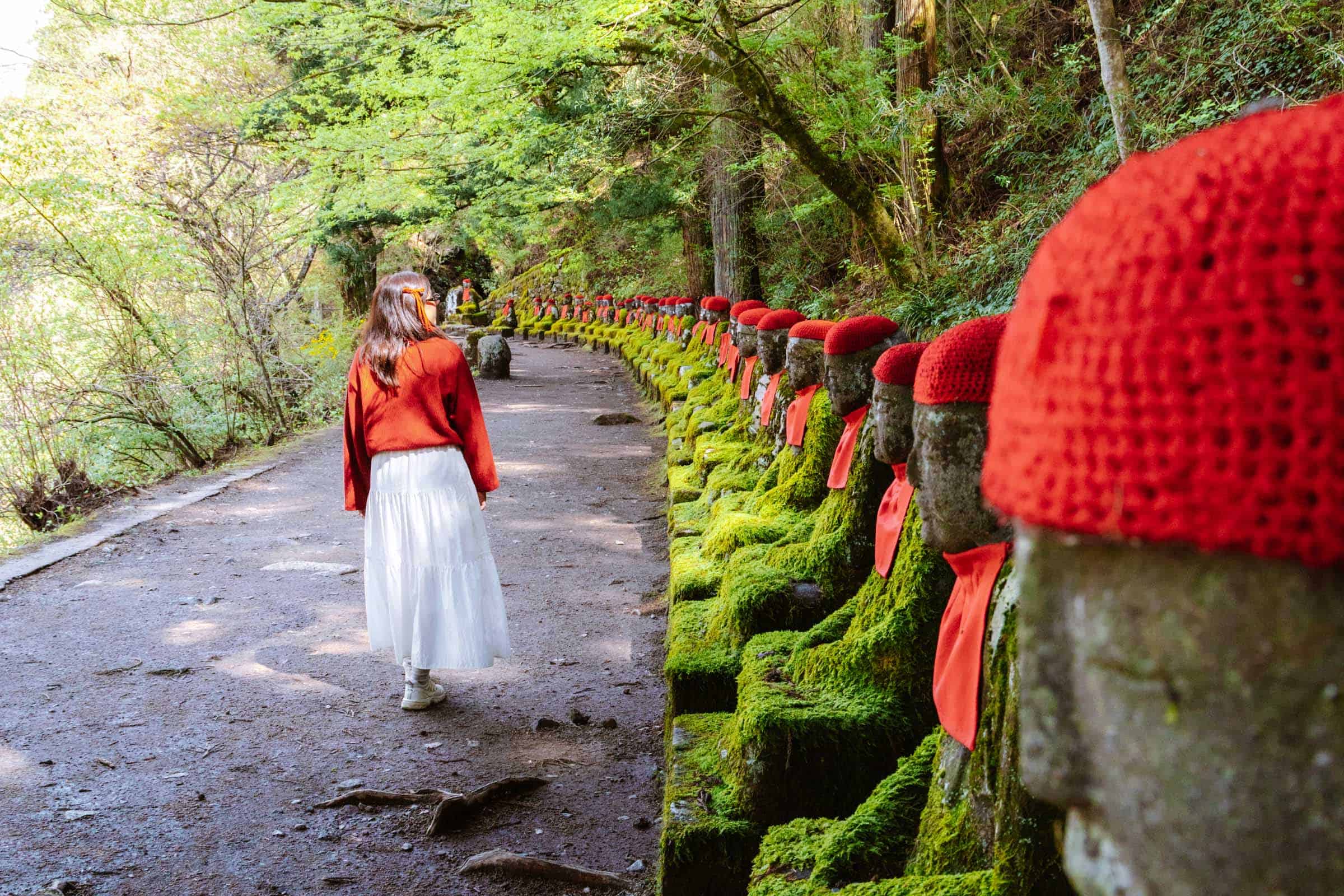
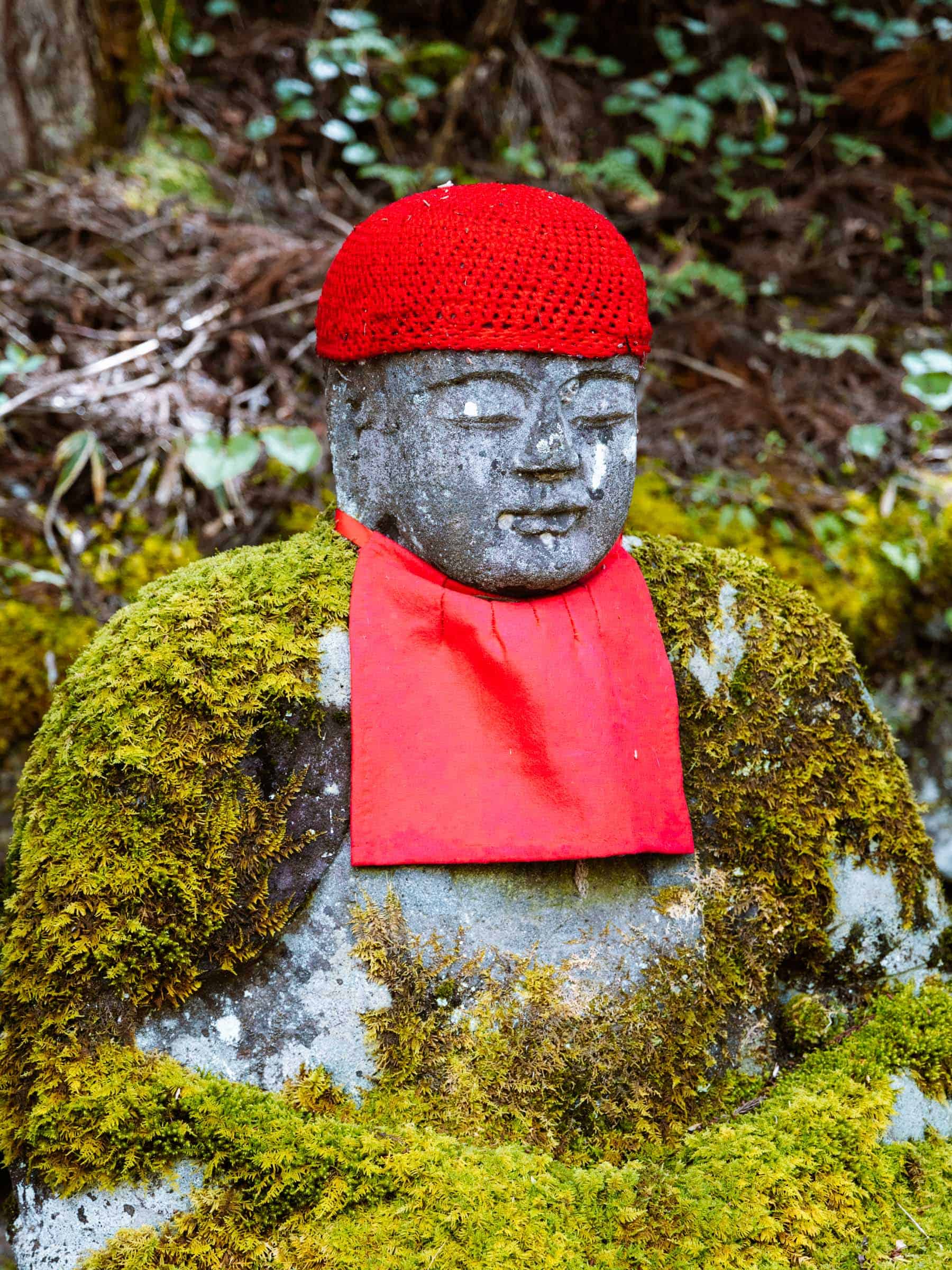
Nikko Tamozawa Imperial Villa
After exploring Kanmangafuchi Abyss, we’re going to stroll back into town and step inside the Nikko Tamozawa Imperial Villa, just a 15-minute walk away.
Built in 1899 as a summer retreat for Japan’s emperor and royal family, this villa now serves as a museum, offering a look into Japan’s imperial history.


With over 100 rooms to explore, the villa showcases the country’s transition from the Edo period to the modern Meiji era.
Upon entering, you’ll notice the harmonious blend of traditional Japanese architecture with Western influences from the Meiji era. The intricate gold designs on the sliding doors and the spacious tatami rooms create an elegant atmosphere, while shoji screens softly filter natural light.

Peering out from any window, you’ll find beautiful views that seamlessly connect the indoors with the villa’s lush surroundings. Stepping outside, the expansive gardens resemble a park, complete with a winding stream.
As you stroll the paths around the villa, take a moment to admire the majestic 400-year-old weeping cherry tree, supported by wooden beams. The villa invites you to reflect on the elegance of Japan’s past while enjoying its natural beauty.

Nikko Botanical Garden
If you still have some time left in the day, then the Nikko Botanical Garden is located nearby and gives you some time to unwind! It’s a perfect escape from the busier tourist areas, so you can relax in nature.
As you walk along the winding paths, you’ll find a diverse collection of plants and flowers, all creating a peaceful atmosphere throughout the garden.
You can easily explore the entire garden in about an hour, making it a perfect option for a quick stroll.
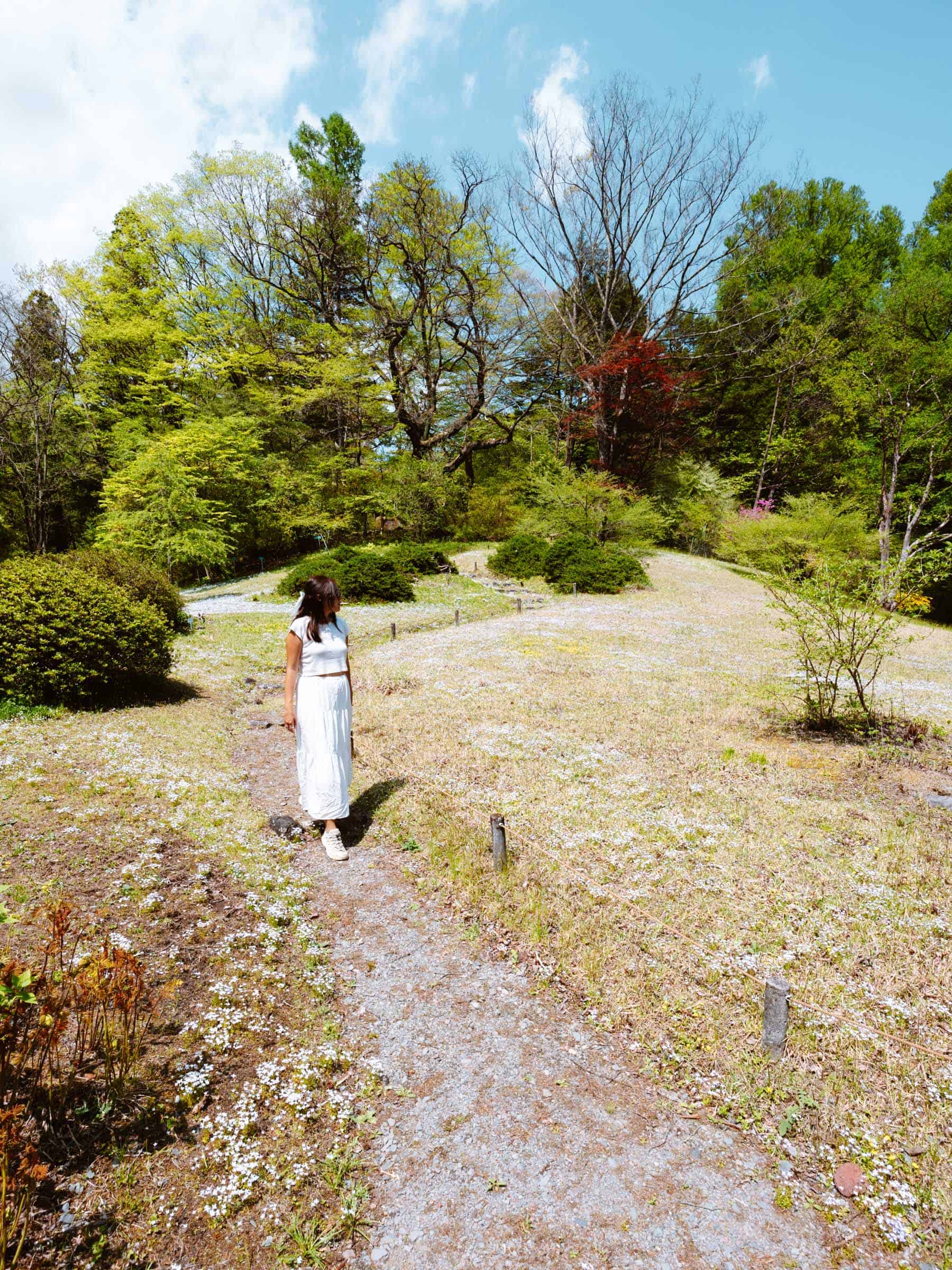

Onsen
After a day of exploring, unwind at Yashinoyu Hot Spring! We visited Yashinoyu multiple times during our stay, and while it’s more of a public bathhouse than a secluded onsen, it offers an authentic experience that gives you a taste of Japan’s onsen culture.
Yashinoyu has several indoor and outdoor baths, and has a relaxed and welcoming atmosphere. It’s a great spot to mingle with locals and fellow travelers alike.
After your soak, grab a bite at the facility’s restaurant, where you can enjoy a meal.
Next, head over to the kyuukeijo, a resting room with tatami mat flooring and comfortable chairs and tables, creating an ideal space to unwind and enjoy a peaceful atmosphere.
Our Free Nikko Google Maps Locations
Do you need a handy map with all our Nikko locations? We’ve got a Google Map with all the Nikko locations in this post (plus a LOT more). Sign up in the box below and we’ll deliver it right to your inbox, plus our top tips to help you plan your Nikko adventure.
Nikko Day 2: Okunikko Waterfalls & Temples
It’s now day 2 of your adventure in Nikko and it’s time to head up the mountain!
On this day, you will leave Central Nikko to explore the Oku-Nikko and Lake Chuzenji area. I’ve included 5 awesome places I recommend visiting.
Irohazaka Winding Road
As you make your way to Lake Chuzenji, you’ll find yourself going up the famous Irohazaka Winding Road.
This iconic mountain route connects Nikko’s central area to the lake and has 48 sharp hairpin turns, divided into two separate roads—one for ascending and another for descending.
Along the drive, there are various pull-offs and observation areas on both sides where you can take a break and soak in the views of the mountains and valleys.
If you’re an anime fan, you’ll appreciate that the Irohazaka Road holds significance in the series Initial D. It’s the spot where Ken taught Kai how to tackle the hairpin turns for racing.
One of the road’s unique highlights is its “musical road” section on the way down! As you go downhill, keep an eye out for a sign indicating music ahead.
When you roll over specially spaced ridges in the pavement, your vehicle produces sweet melodies! The clever design creates distinct musical notes that come together to form a song!
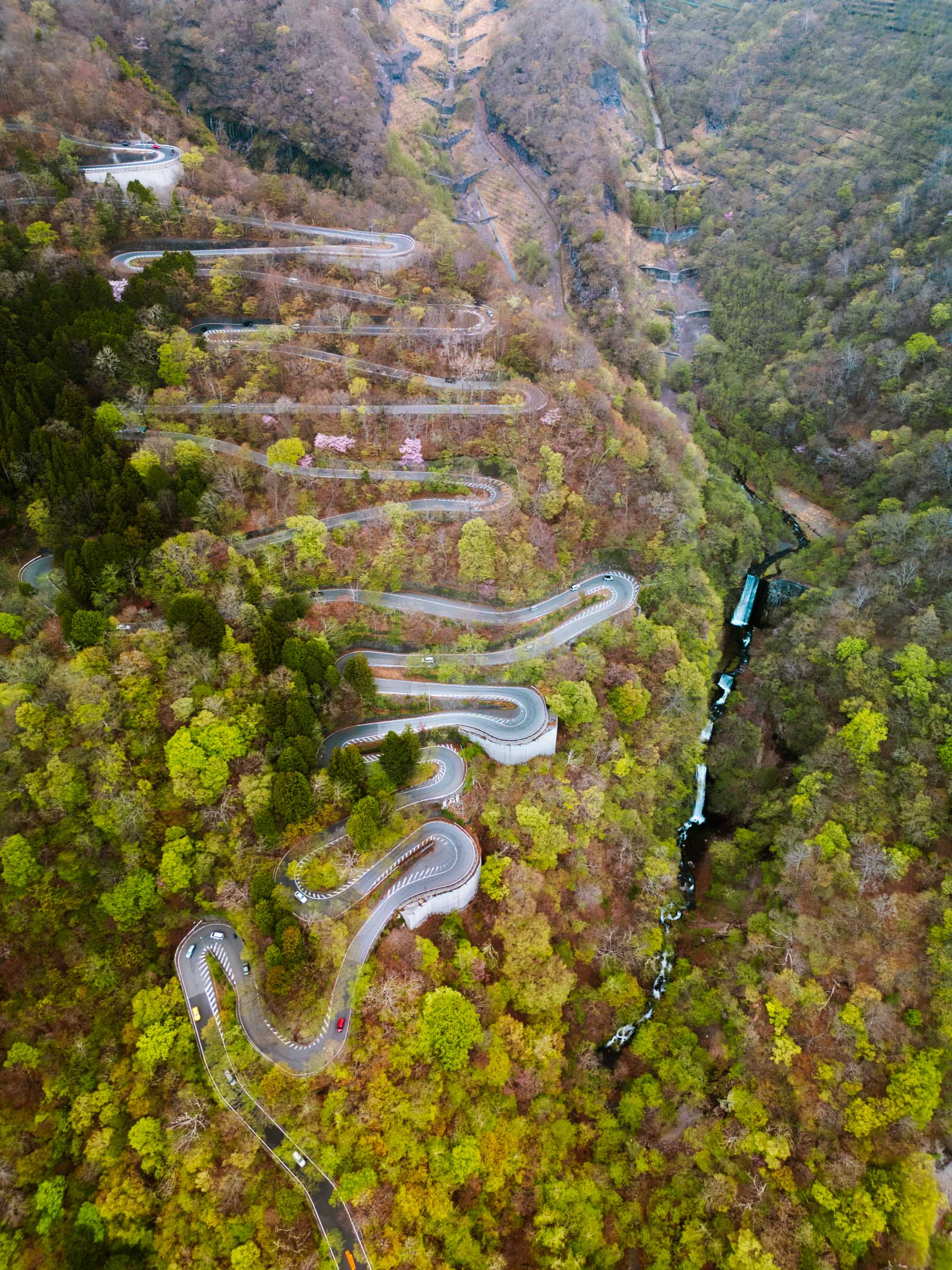
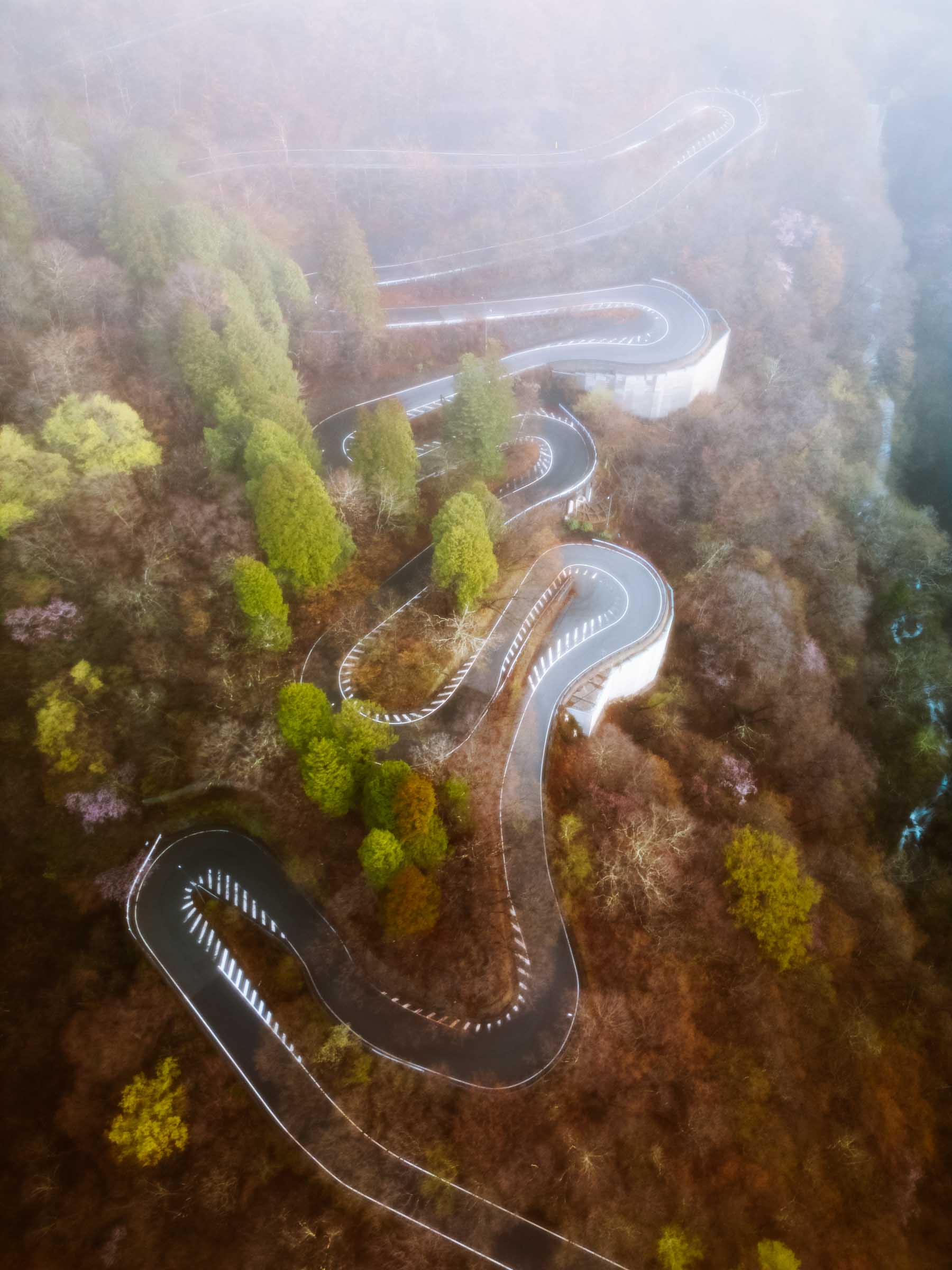
Kegon Waterfall
After going up the scenic Irohazaka Winding Road, your first stop of the day is Kegon Waterfall.
This massive waterfall plunges 97 meters from Lake Chuzenji into the Daiya River below, earning its title as the most famous waterfall in Nikko and one of the “Three Great Waterfalls of Japan.”

To view the falls, go to the observation deck that overlooks Kegon Falls from above.
If you want to get closer to the action, ride the elevator down to the base for an up-close view of this massive waterfall.

Chuzenji Temple
After marveling at Kegon Waterfall, make your way to the nearby Chuzenji Temple, which is nestled on the eastern shore of Lake Chuzenji.
Interestingly, the lake got its name from the temple, not the other way around!
Founded in 784 by Priest Shodo—who also established Rinnoji Temple—Chuzenji Temple was the second temple in Nikko.
One of the highlights of this temple is its wooden Buddha statue, believed to have been carved by Priest Shodo himself.
When visiting, you can explore the temple in an organized manner with a guided tour through the interior of the complex.
Be aware that photography is prohibited in many of the temple’s halls to preserve the sanctity of the space.
But once you step onto the wooden veranda, you’re free to take as many photos as you like to capture the breathtaking views of Lake Chuzenji framed by the temple grounds.
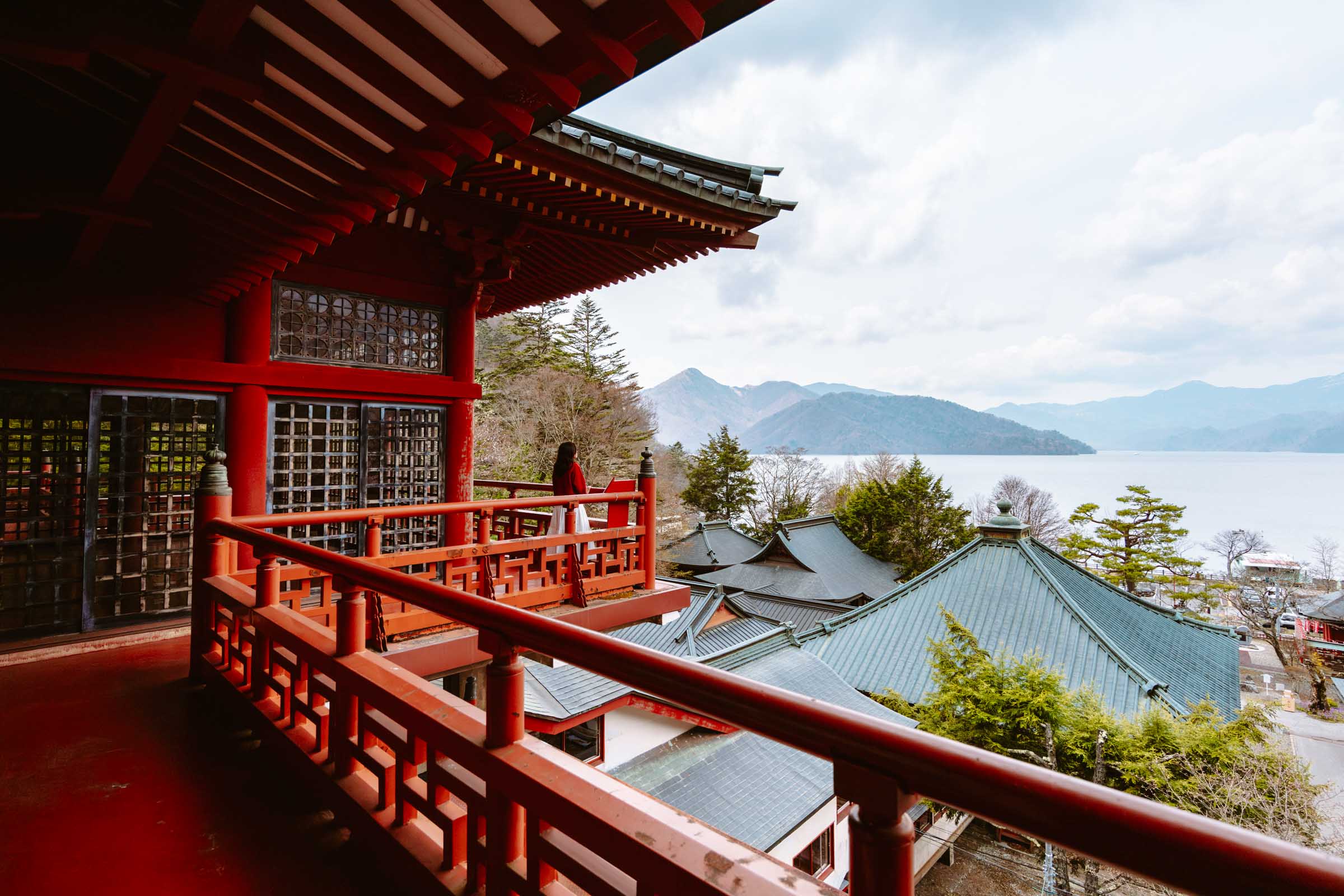

Futarasan-jinja Shrine Chugushi
After you visit Chuzenji Temple, enjoy a scenic 25-minute walk through town to reach Mt. Futara Shinto Shrine, also known as Futarasan-jinja Shrine Chugushi.
The Futarasan-jinja Shrine Chugushi is dedicated to the deity of Mt. Nantai, one of Nikko’s revered sacred mountains.
As you enter through the Torii Gate, you’ll feel the shift into a sacred space. Take a moment to admire the shrine’s traditional wooden architecture, which harmonizes with its natural surroundings.
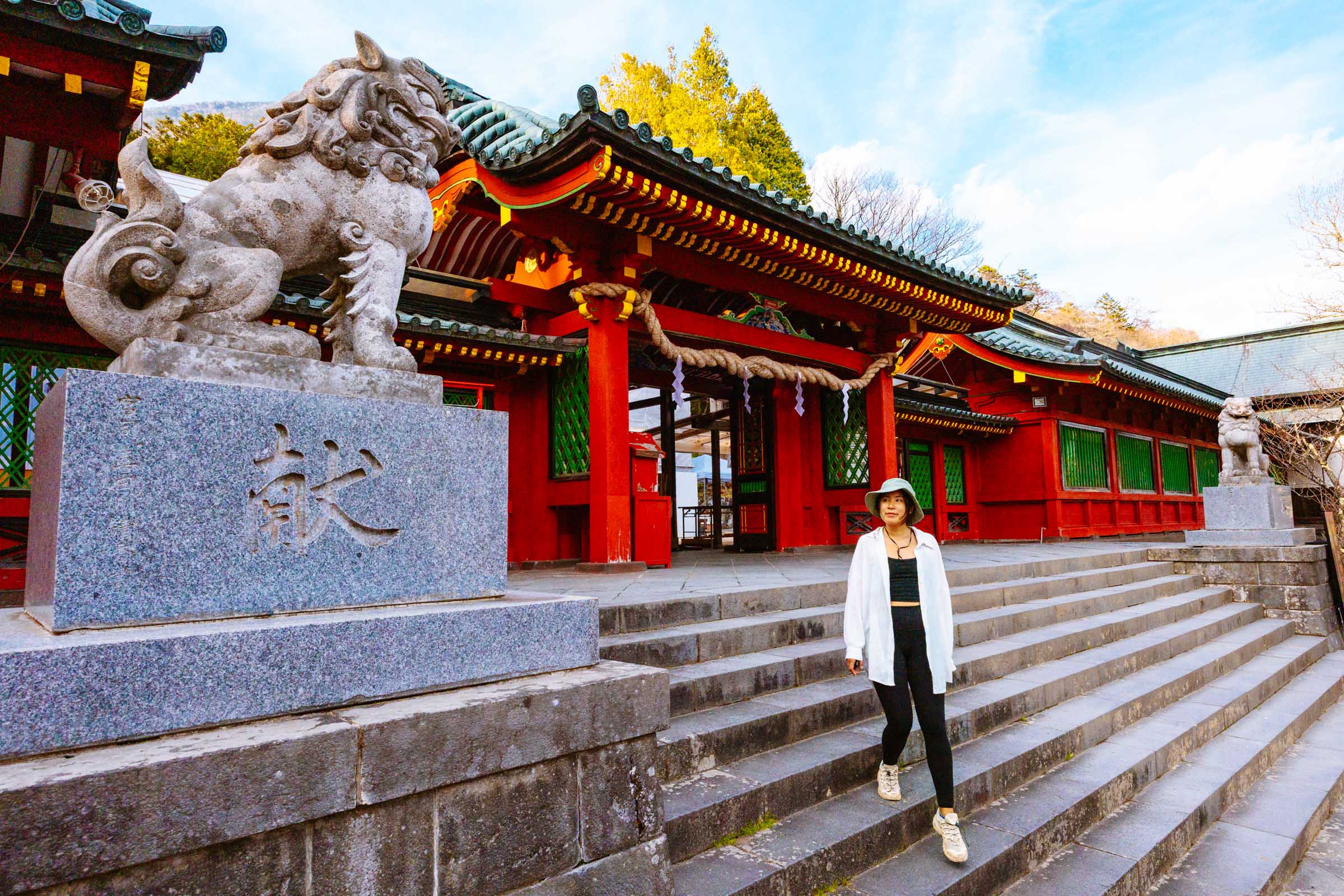
Don’t miss the main hall (Honden), where visitors come to pray for good fortune, safety, and success. Keep an eye out for the Shimenawa, the sacred rope wrapped around trees and structures, signifying a divine presence.
If you’re up for an adventure, you can find the trailhead to Mt. Nantai behind the shrine. Doing the hike requires a ____ yen donation to the temple.
If hiking isn’t on your agenda, spend some time exploring the peaceful ambiance of the shrine and its surroundings.
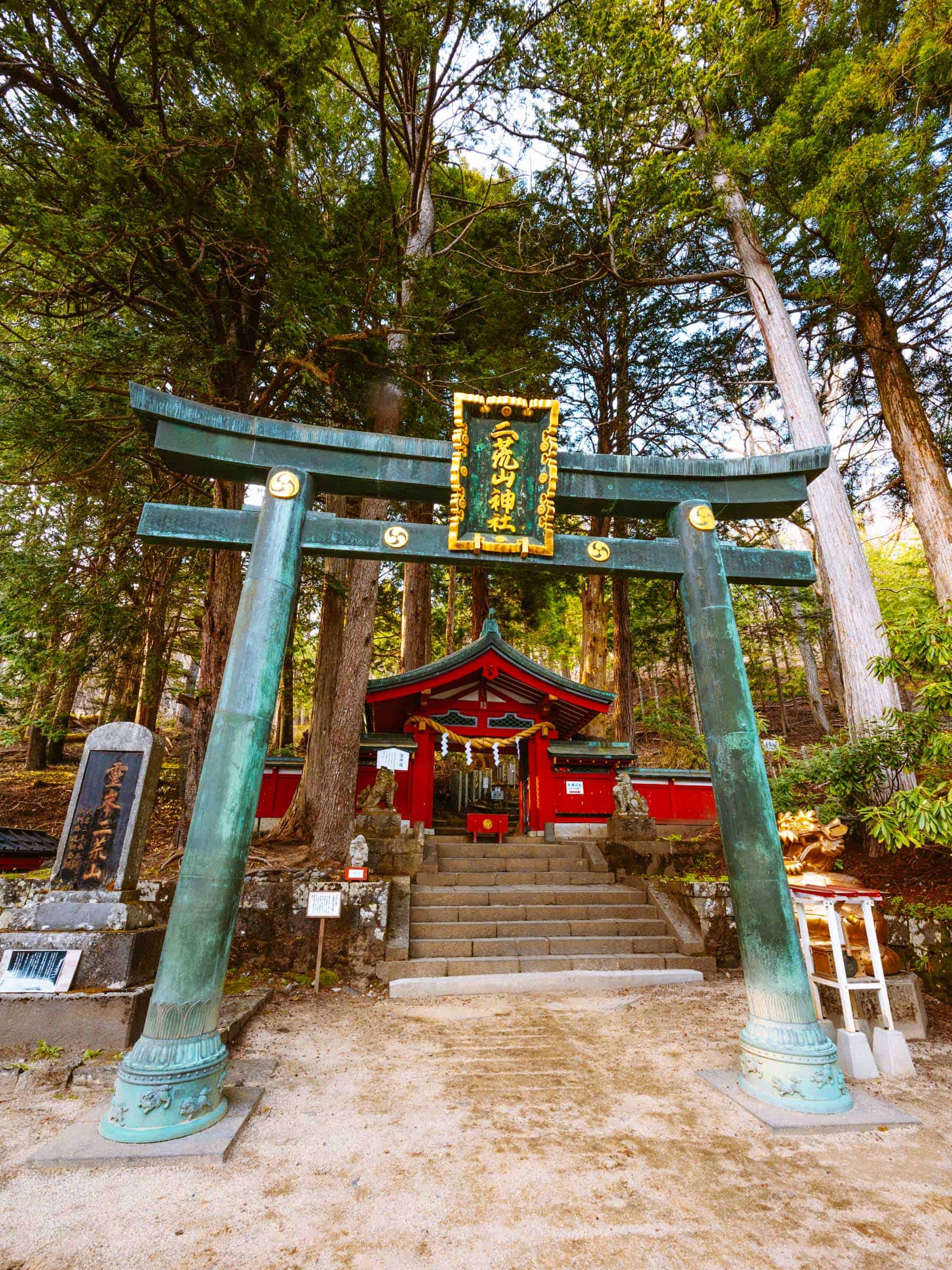
Ryuzu Waterfall
After visiting Futarasan-jinja Shrine, make your way to Ryuzu Falls, an easily accessible waterfall located near Lake Chuzenji, just off the main road.
Known as one of Nikko’s three most famous waterfalls, Ryuzu Falls consists of twin cascades that split around a rock, creating a resemblance to a dragon’s head—hence its name, which means “Dragon Head Waterfall.”
The best vantage point for Ryuzu Falls is from the observation deck located behind the teahouse, where you can take in the view of the falls up close!
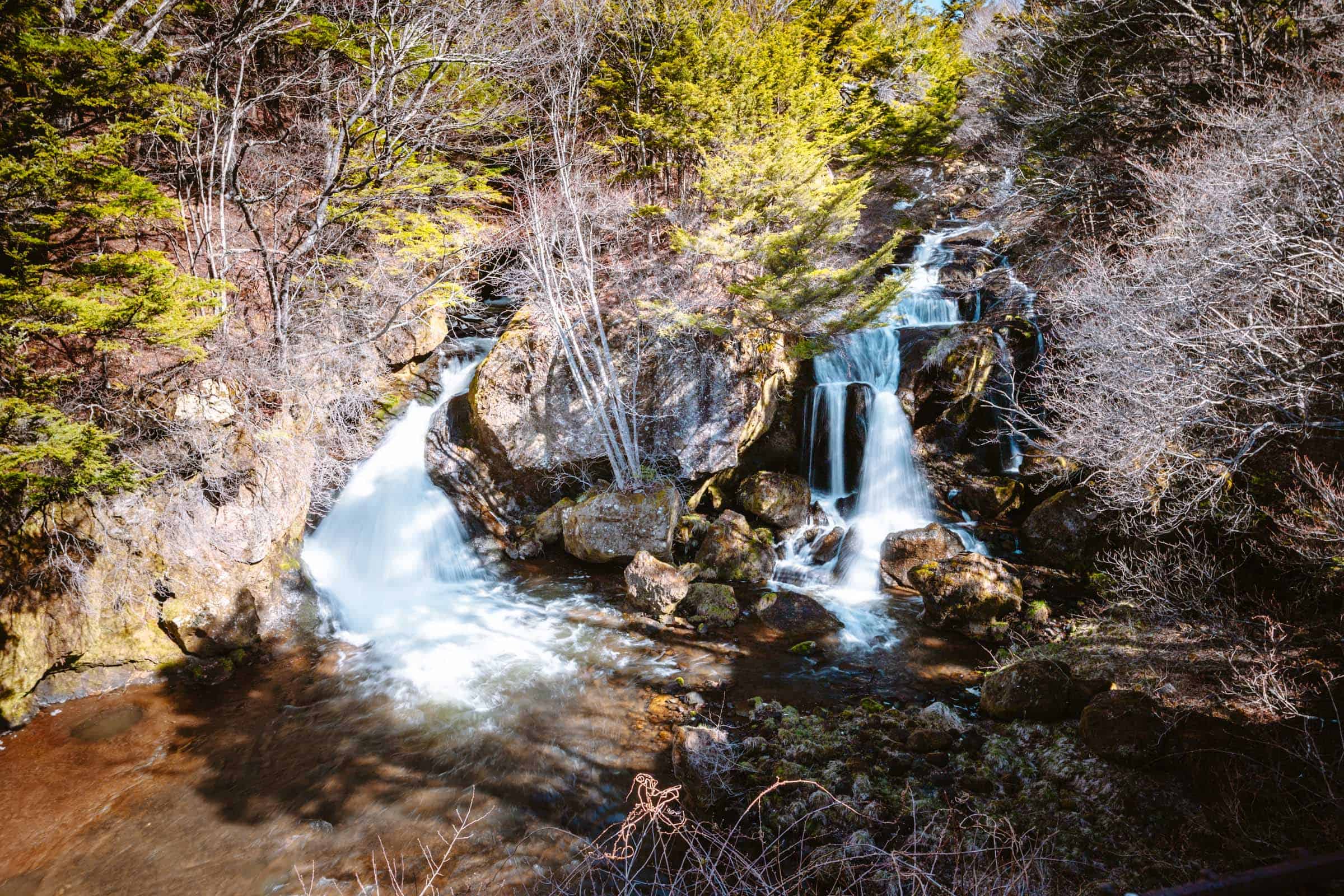
If you’re interested in exploring further, take the stairs next to the teahouse that lead to a paved walking path along the river. This short trail gives you a closer look at the upper rapids as they cascade down toward the falls.
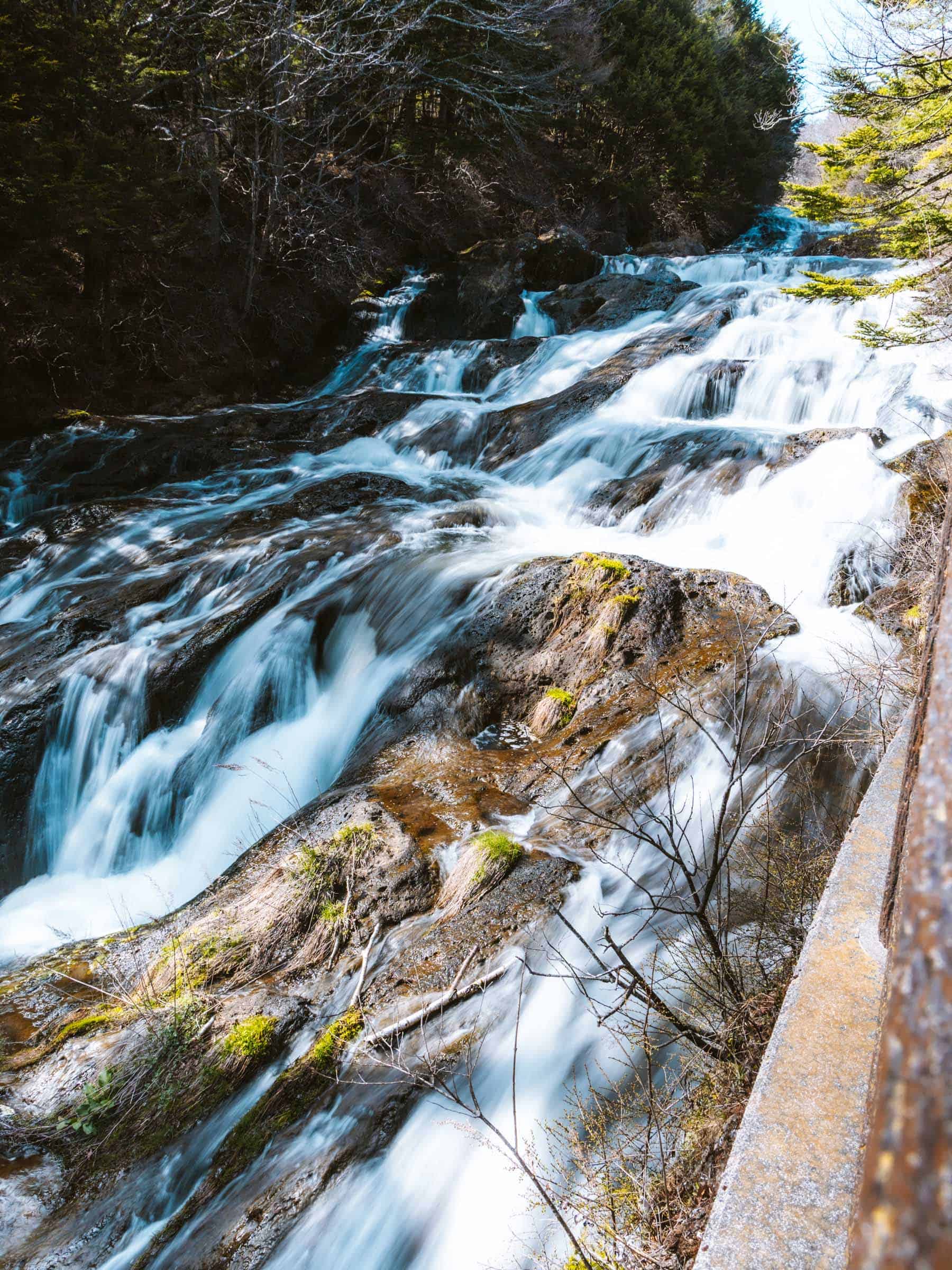
Looking for more things to do in Nikko?
Nikko has so much more to offer beyond the highlights covered in this itinerary. From stunning natural landscapes and serene temples to cultural experiences and engaging outdoor activities, this mountainous region of Japan is filled with adventures.
If you’re eager to discover even more ways to experience the best of Nikko, be sure to check out our complete guide to Things to Do in Nikko. It’s packed with recommendations that will help you make the most of your time in this Japanese mountain town!
Read our full blog post: 18 Incredible Things to Do in Nikko: Complete Travel Guide
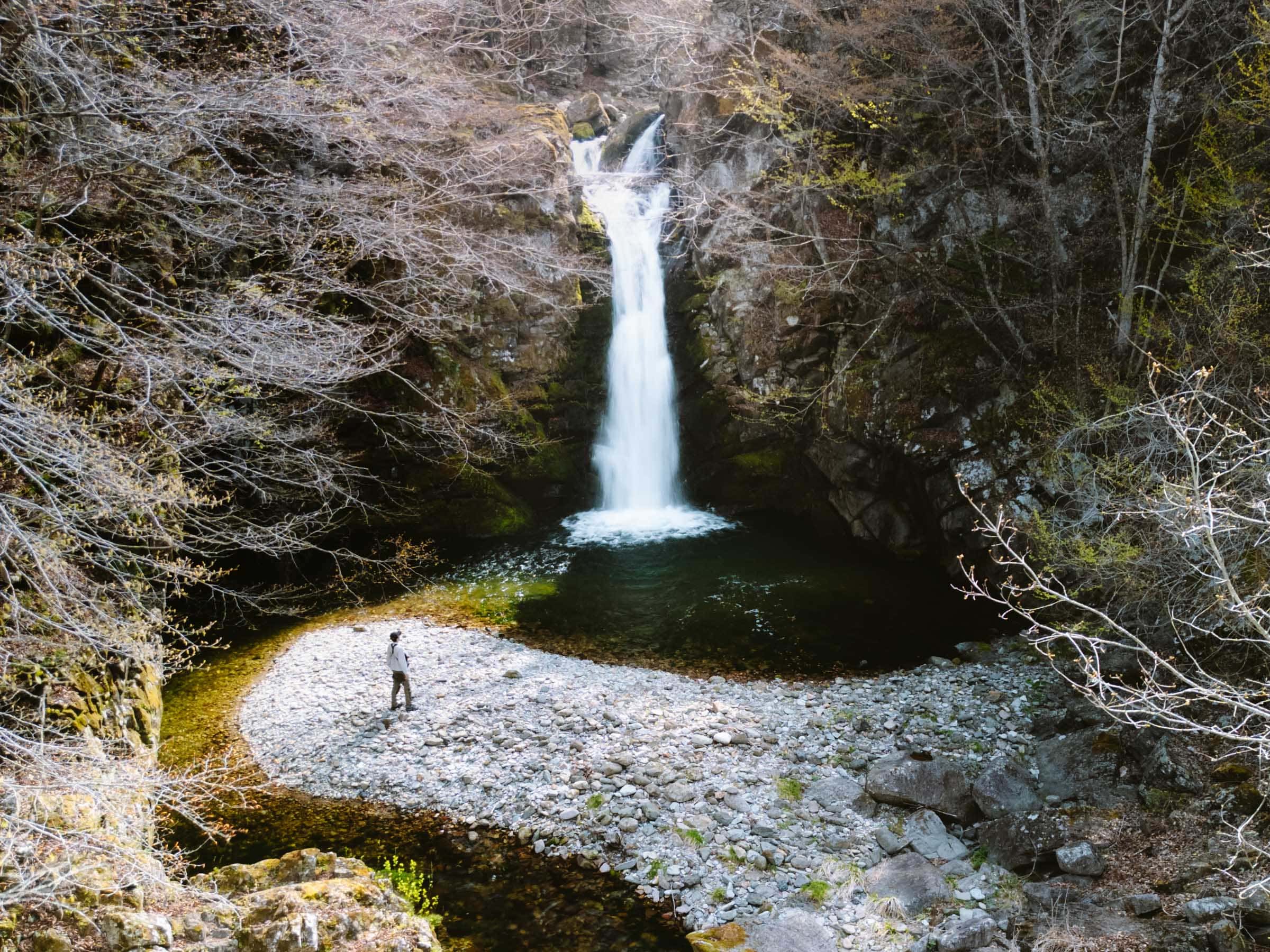
Our Free Nikko Google Maps Locations
Do you need a handy map with all our Nikko locations? We’ve got a Google Map with all the Nikko locations in this post (plus a LOT more). Sign up in the box below and we’ll deliver it right to your inbox, plus our top tips to help you plan your Nikko adventure.

Are You Following Our Nikko Blog Series?
We spent 5 days in Nikko and found so many things to do there — from imperial architecture and cultural immersion to epic waterfalls and outdoor adventures. To help fellow travelers, we’ve put together guides to the best places we found. You can check them out by clicking the links below.
- Our ultimate guide to Nikko: 18 Incredible Things to Do in Nikko: Complete Travel Guide
- How to plan your Nikko trip: 2 Days in Nikko: The Perfect Nikko Itinerary
- Our Nikko waterfalls guide: 7 Best Waterfalls in Nikko: Complete Guide
- Kanmangafuchi Abyss is the cutest little off-the-beaten-path spot in Nikko
- The Nikko Tamozawa Imperial Villa is a beautifully preserved retreat of Japan’s imperial family, now open as a museum
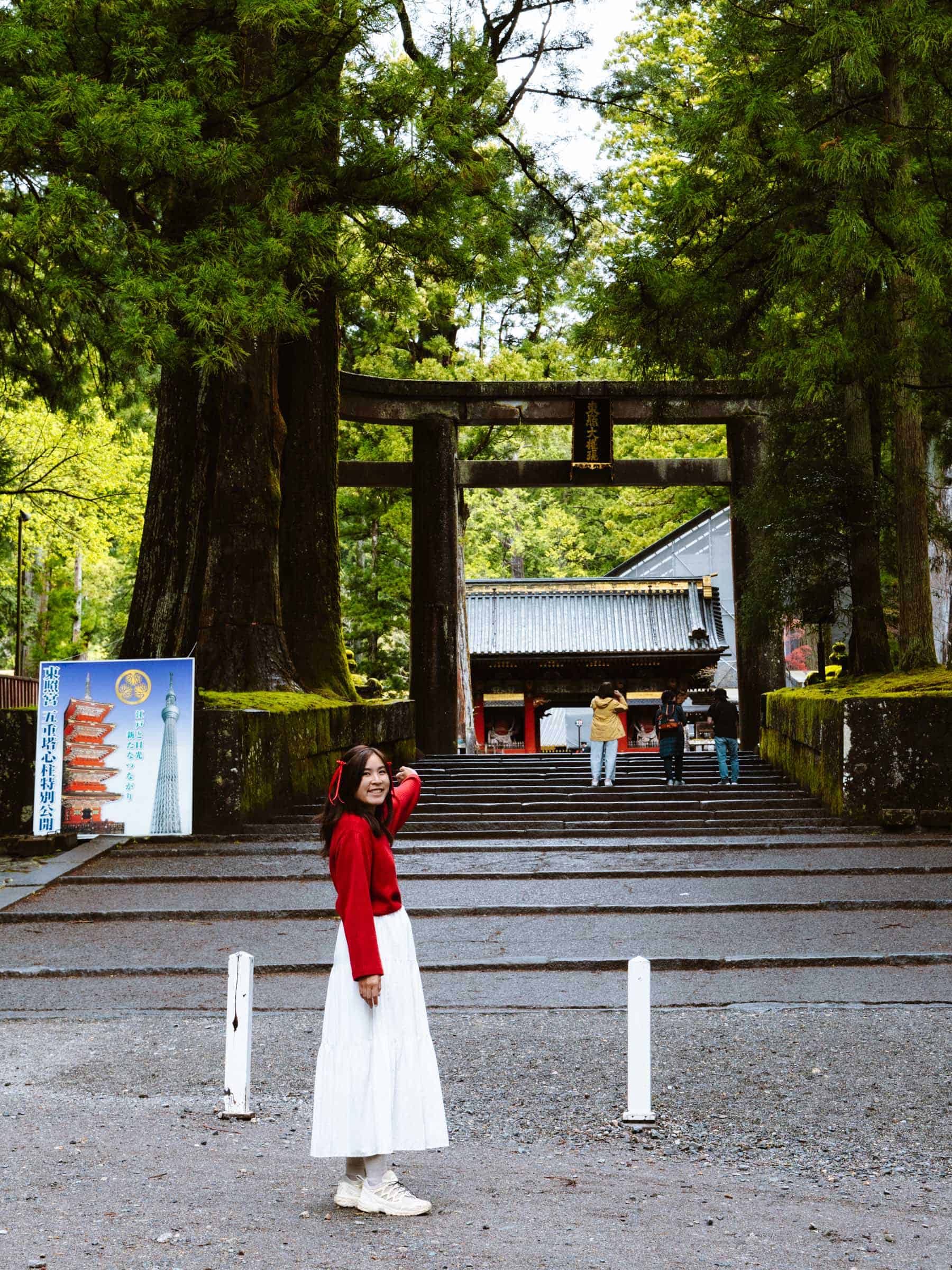
I hope you enjoyed my 2-day Nikko itinerary! Feel free to leave a comment below if you have any questions 🐸


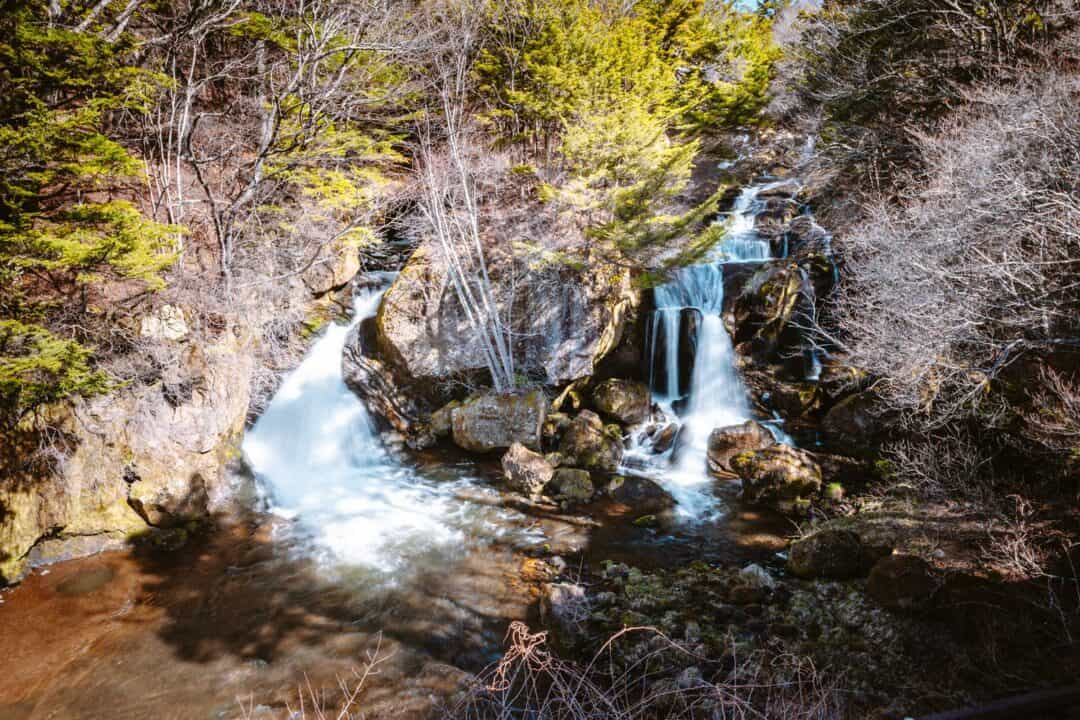

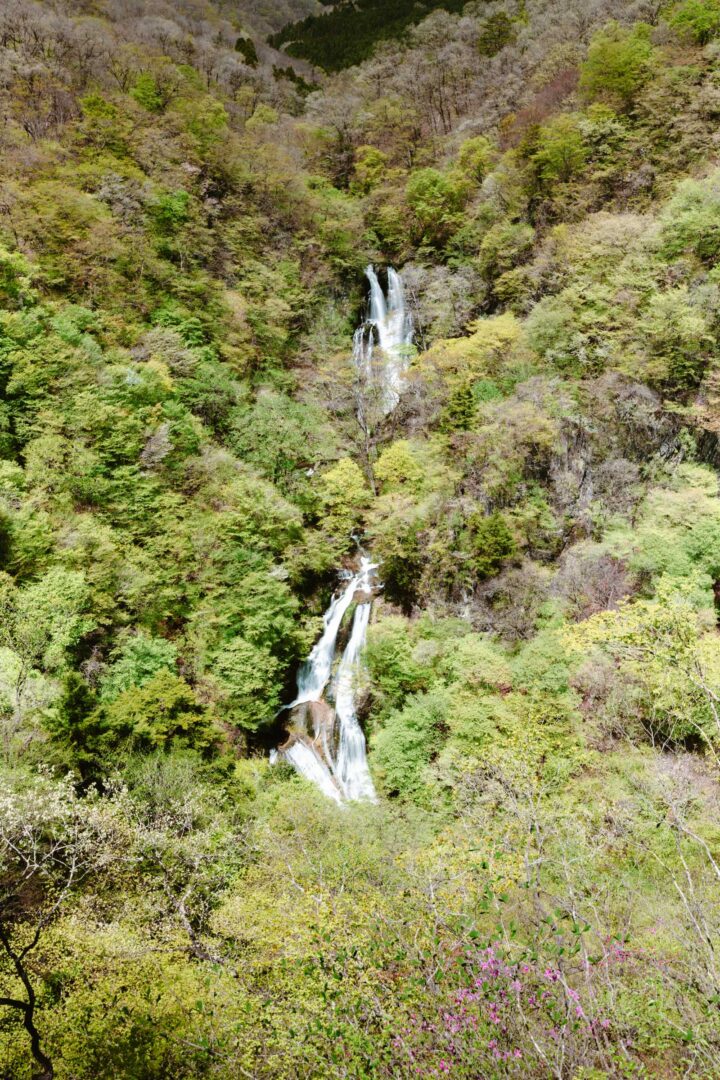

Please send map